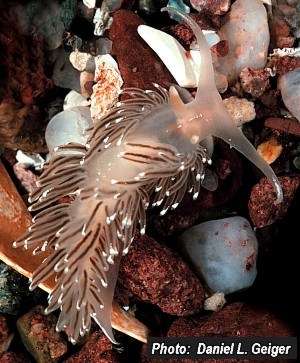
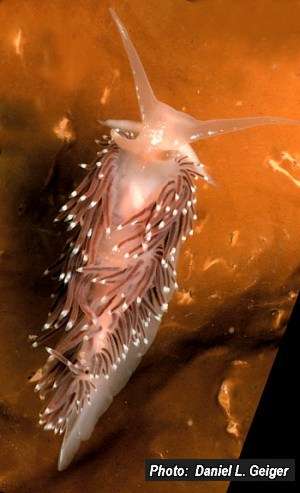
Facelina bostoniensis
(Couthouy, 1838)
Order: NUDIBRANCHIA
Suborder: AEOLIDINA
Family: Glaucidae
DISTRIBUTION
Throughout western Europe from Norway to the western Mediterranean. Also northeast coast of North America.
PHOTO
UPPER: Millport, Ballachmartin Bay, Isle of Cumbrae, Scotland, May 1993
LOWER: As above, May 1992 PHOTOS: Daniel Geiger.
Facelina bostoniensis grows to about 55mm. In British waters it is reported to feed almost exclusively on species of the hydroid genus Tubularia. Brown (1981) showed that this common European species also occurs on the northeast coast of North America where it was named Facelina bostoniensis, from specimens Couthouy found in Massachusetts about 5 years before Alder & Hancock (1843) described it from England as Eolis curta. It is not often that animals found on both sides of the Atlantic have a name with an American connection. Usually, species common to both coasts were named by European workers long before they were studied in North America.
Reference:
• Thompson, T.E. & Brown, G.H. (1984) Biology of Opisthobranch Molluscs, Vol 2. Ray Society: London.
See Betsey Hansen's photos of North American specimens below.
See Jussi Evertsen's message reporting it feeding on the sea pen Virgularia mirabilis
Rudman, W.B., 1999 (August 7) Facelina bostoniensis (Couthouy, 1838). [In] Sea Slug Forum. Australian Museum, Sydney. Available from http://www.seaslugforum.net/find/facebost
Related messages
Facelina bostoniensis burrowing
April 29, 2010
From: Jerry Shine
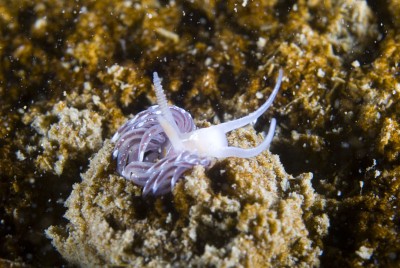
Hello Bill,
I've attached a photo of a Facelina bostoniensis exhibiting burrowing behavior. I've read that F. bostoniensis has been found off Northern Ireland in the empty burrows of rock-boring clams but haven't found anything else in that regard. The bottom here is not rock but mud. Several minutes after taking this shot, I witnessed a second F. bostoniensis doing the same thing. Currents in the area are minimal.
Locality: Whale Cove, Rockport, 5 meters, Massachusetts, USA, Atlantic Ocean, 23 April 2010, muddy. Length: 20mm. Photographer: Jerry Shine.
Thanks.
Jerry
shine@bluespherepubs.com
Shine, J., 2010 (Apr 29) Facelina bostoniensis burrowing. [Message in] Sea Slug Forum. Australian Museum, Sydney. Available from http://www.seaslugforum.net/find/23561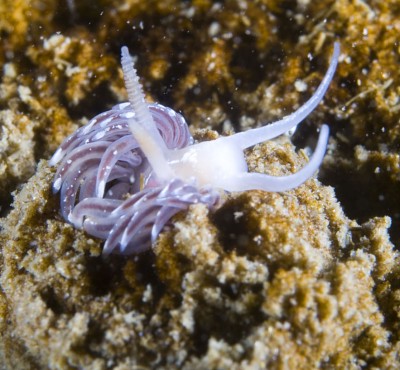
Dear Jerry,
This is an interesting observation. From your photo the animal appears to be coming out of a burrow. What would be nice to know is whether they actually burrow into the mud - that is make their own burrow, or do they just make use of empty burrows made by worms or other assorted burrowers.
Best wishes,
Bill Rudman
Facelina bostoniesis in Massachusetts, USA - feeding observations
April 7, 2010
From: Jerry Shine
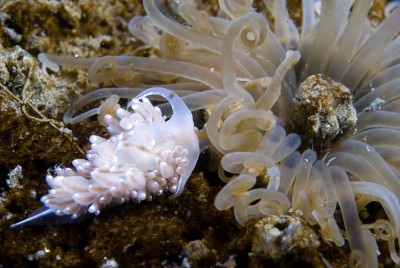
Hello Bill,
Here is a shot of a Facelina bostoniesis attacking a Cerianthus borealis. I have not seen this cnidarian listed as part of the typical diet of F. bostoniesis. When it made contact with a tentacle, the cerianthid immediately retracted into the bottom, taking the nudibranch down with it.
The second shot was taken later on the same dive. A F. bostoniesis was head on into a Cuthona nana. Thompson has written that in lab vessels, F. bostoniesis will attack other nudibranchs. Any ideas if that is the case here? I was able to observe them for less than a minute because it was at the end of the dive and I was almost out of air but they did not move during that time.
Locality: Old Garden Beach, 5 meters, Massachusetts, USA, Atlantic Ocean, 05 April 2010, sand/silt. Length: 20mm. Photographer: Jerry Shine.
Jerry Shine
shine@bluespherepubs.com
Shine, J., 2010 (Apr 7) Facelina bostoniesis in Massachusetts, USA - feeding observations. [Message in] Sea Slug Forum. Australian Museum, Sydney. Available from http://www.seaslugforum.net/find/23449
Dear Jerry,
This is an interesting pair of observations. Firstly I dont know of any other records of an aeolid feeding on a cerianthid, although at least one other nudibranch, Dendronotus iris, feeds on them. Facelinids [phidianids] are usually hydroid feeders but many are known to eat other nudibranchs and carcases of some dead invertebrates, so it is highly probable that it is feeding on the Cuthona. Interestingly, Jussi Evertsen [message #11463] reports F. bostoniensis feeding on another cnidarian group - the sea pens.
It seems we still have a bit to learn about this species' diet
• Evertsen, J. & Bakken, T. 1999. Additional data on the food-preferences of the nudibranch Facelina bostoniensis (Couthouy, 1838) (Aeolidoidea: Facelinidae). Opisthobranch Newsletter, 25: 33-34.
Best wishes,
Bill Rudman
Re: Facelina auriculata? from Mediterranean
May 25, 2009
From: Greg Brown

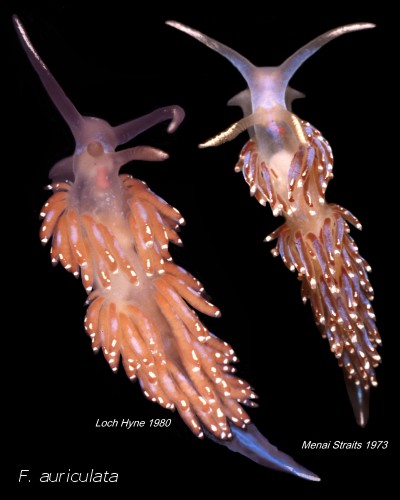
Concerning message #22462:
Hi Bill,
Very glad to see the Forum back providing interesting sightings.
I'd just like to support Dominique's earlier suggestion of Facelina bostoniensis as the identification for his animal. Tom Thompson and I always reckoned the broader foot and general body outline, relatively longer cerata and scattered white pigment between the rhinophores was indicative of F. bostoniensis in European waters. All the other messages on the Forum giving Facelina auriculata as the identification would agree with our idea of this close species but not Dominique's. I attach compiled photos of examples of the two species from British waters which hopefully illustrate the subtle differences.
Locality: British west coast sites, 20 m, U.K., Atlantic
Best regards,
Greg Brown
sally.andgreg7@ntlworld.com
Brown, G.H., 2009 (May 25) Re: Facelina auriculata? from Mediterranean. [Message in] Sea Slug Forum. Australian Museum, Sydney. Available from http://www.seaslugforum.net/find/22494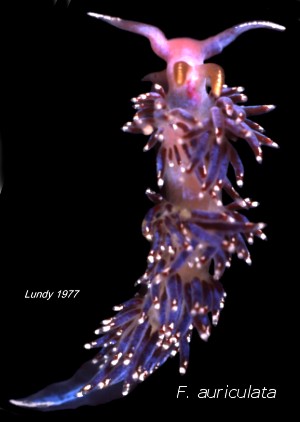
Dear Greg,
Thanks for this valuable set of photos which certainly clarify the differences between these two species. I'm not quite sure why I identified Dominique's animal as F. auriculata - it is clearly F. bostoniensis.
Best wishes,
Bill Rudman
Facelina auriculata? from Mediterranean
May 18, 2009
From: Dominique Horst
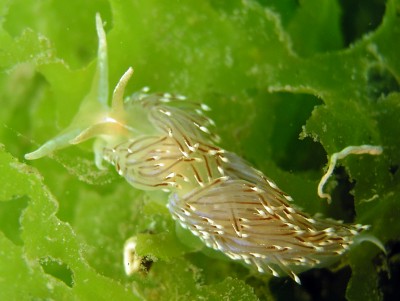

Hi Bill,
Could you please help us about the id of this slug. We initially think about Flabellina lineata, but the line is short and not present along the mantle.
So we are thinking about Facelina bostoniensis, but rhinophores are not ringed, so in the end we arrived to Facelina dubia?
Locality: Thau, 4 m, France, Mediterranean sea, 24 June 2007. Length: 5 cm. Photographer: Elisabeth Juan.
Many thanks in advance,
Kind regards,
Dom
dominique.horst@wanadoo.fr
Horst, D., 2009 (May 18) Facelina auriculata? from Mediterranean. [Message in] Sea Slug Forum. Australian Museum, Sydney. Available from http://www.seaslugforum.net/find/22462
Note added 15 May 2009: This is Facelina bostoniensis. See Greg Brown's message [#22494].
Dear Dom,
I am pretty sure this is Facelina auriculata. I suspect the wrinkles on the rhinophores are not just folds caused by the partial retraction of the rhinophores but are in fact rings. When we add the bluish band on the oral tentacles, the reddish oesophagus we can see just behind the base of the rhinophores, and the first ceratal group on each side being separate from the rest, it has the main external features of that species.
Best wishes,
Bill Rudman
Facelina bostoniensis from Istanbul
July 11, 2007
From: Goker Goksel
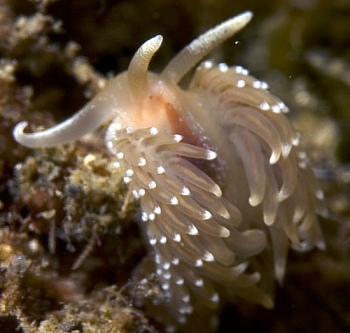
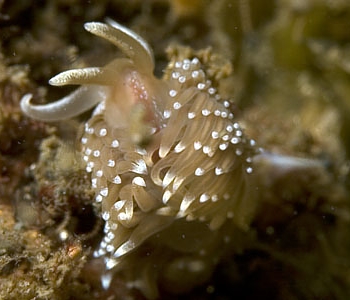
Dear Bill,
The photo attached belongs to an unknown nudibranch. We sent this photo first to Baki Yokes who you probably know. He told us that he really could not tell what this is. We have been waiting to ask this to you for months now. We are constantly browsing your forum and database and could not find a match.
Locality: Yassiada, Istanbul, 30m, Turkey, Marmara Sea, 08 October 2006, muddy. Length: ~20mm. Photographer: Goker Goksel.
Hope you can help us.
Goker Goksel & Tunca Rodoplu
gokerg@yahoo.com
Goksel, G., 2007 (Jul 11) Facelina bostoniensis from Istanbul. [Message in] Sea Slug Forum. Australian Museum, Sydney. Available from http://www.seaslugforum.net/find/20151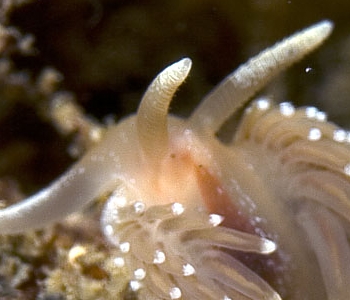
Dear Goker & Tunca,
I am pretty sure this is Facelina bostoniensis. The annulations [ring-like ridges] on the rhinophores and the white pigmentation on the tips of the cerata and along the oral tentacles, and as a median line on the posterior part of the foot, are all good characters of this species.
Best wishes,
Bill Rudman
Facelina bostoniensis mating
June 27, 2007
From: Christian Skauge
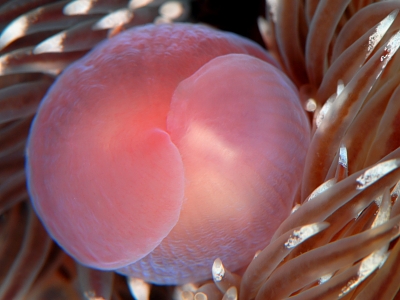
Hello Bill,
I just thought you might want to use the enclosed image on your pages. It shows two Facelina bostoniensis mating, and the ball presumably consists of their respective sexual organs - I guess. I think it is a striking and unusual image. I've also included a that shows the head and cerata of the slug. With my 105mm + 1,4 teleconverter, I couldn't get any further away.
post@dykkefoto.no
Skauge, C., 2007 (Jun 27) Facelina bostoniensis mating. [Message in] Sea Slug Forum. Australian Museum, Sydney. Available from http://www.seaslugforum.net/find/20017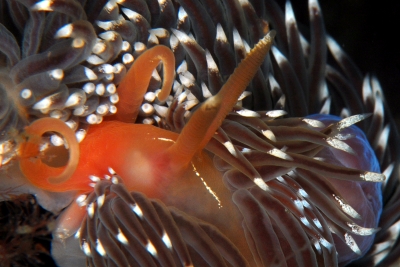
Thanks Christian,
It is a striking photo - the sort you could put in a mystery picture competition. As you say, it is part of their mating apparatus but I can't be any more specific than that. This group of aeolids often have quite elaborate 'glands' and secondary organs associated with their penis and in most cases we have no idea how they function during copulation. All these organs sit inside the body 'outside in', much like the inturned finger of a rubber glove which only comes out when you blow into the glove. We only know about these structures when we dissect the preserved animal and usually the organs are 'outside in' and it is difficult to guess just how each will extend and inflate when in use.
Best wishes,
Bill Rudman
Facelina bostoniensis - feeding information
July 8, 2006
From: Vincent Maran
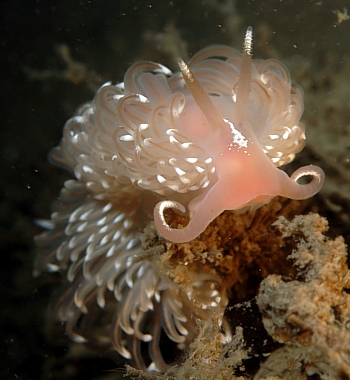
Bonjour !
I saw about 10 Facelina bostoniensis (with eggs) in a place where there was no Tubularia nor Clava but there were other hydrozoa....
Locality: Sharendijke, 15 metres, Netherlands, North sea, 02 July 2006, on Polydora ciliata. Length: about 50 mm. Photographer: Vincent Maran.
Could Facelina bostoniensis could eat something else than Tubularia and Clava?
Best wishes
Vincent Maran
vincent.maran@ac-lille.fr
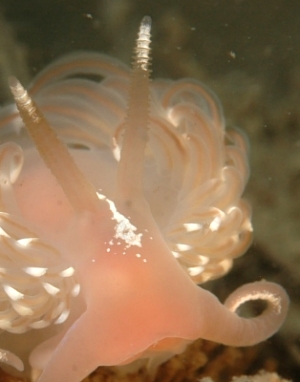
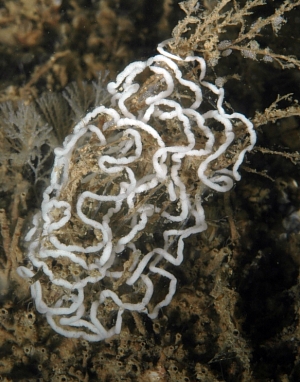
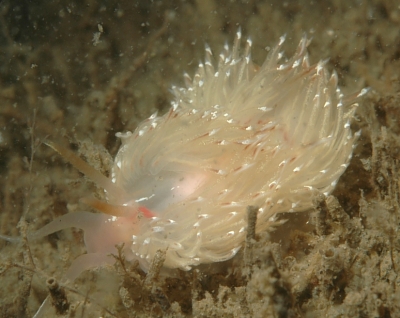
Dear Vincent,
Thompson & Brown (1984) report this animal feeding on the hydroids Tubularia larynx, T. indivisa and Clava multicornis, but they note that 'if hungry, virtually any hydroid will be attacked'. Jussi Evertsen also has observed it feeding on a sea pen [message #11463]. It is also possible your animals have just eaten out a colony of Tubularia and are in the process of looking for some more of their desired hydroids.
Thanks for the photo of the egg ribbon. I have also included a close-up showing the annulations on the rhinophore. The photo alongside shows a red mark just behind the rhinophores. This is the anterior part of the oesophagus, which is quite often red in this species.
-
Thompson, T.E. & Brown, G.H. (1984) Biology of Opisthobranch Molluscs, Vol 2. Ray Society: London
Best wishes,
Bill Rudman
Facelina bostoniensis or Coryphella sp.?
March 4, 2004
From: Rebecca Asch
Hi folks,
I am a graduate student at the University of Rhode Island, who is trying to identify some nudibranchs taken from dredge samples on Georges Bank. (FYI, Georges Bank is located offshore of Massachusetts, USA). According to two different marine invertebrate identification keys (Weiss, 1995; Gosner, 1971), Facelina bostoniensis is identified by the annulated rings present on its rhinopores. Species from the genus Coryphella are not supposed to have these annulated rings.
When looking through our laboratory's reference collection from Georges Bank, I found several nudibranchs identified as Coryphella sp. that had annulated rings. At first, I just figured that these specimens may have been misidentified. However, I found a picture of Coryphella verrucosa in a guide book on North Atlantic marine species (Martinez, 1994) that also looks like it has annulated rings on its rhinopores. Next, I did a Google image search and found other pictures pictures of Coryphella spp. that also appear to have annulated rings. One example of such an online photograph is the picture of Coryphella browni posted on: http://www.habitas.org.uk/marinelife/index.html
A second example is the photograph of Coryphella verrucosa posted on the following website: http://www.marinbi.com/nudibranchia/coryphella_verrucosa.htm
Are these photographs identified correctly? If so, do some species from the genus Coryphella also have annulated rings on their rhinopores?
Going back to our specimens from Georges Bank, the rhinopores are obviously annulated, but do not seem to be as long as the rhinopores shown in most pictures of Facelina bostoniensis. The samples were collected offshore at a depth of 50 m in an area characterized by gravel substrate. The particular specimen that I am examining was collected last November. However, we also have some similar looking, older specimens that were collected in past years during different seasons.
Any help with this matter would be greatly appreciated.
Thanks,
Rebecca
rasch@gso.uri.edu
Asch, R., 2004 (Mar 4) Facelina bostoniensis or Coryphella sp.?. [Message in] Sea Slug Forum. Australian Museum, Sydney. Available from http://www.seaslugforum.net/find/12329Dear Rebecca,
Firstly most workers consider the genus Coryphella to be a synonym of Flabellina so you will find more under that name than under Coryphella. We do have a key on the Forum to the Nth Atlantic species of Flabellina which you might find useful.
What I am not sure is if your are trying to identify these from living or preserved animals. If you are looking at preserved animals you may have problems even if the animals were relaxed when preserved because there is always some contraction and so smooth rhinophores, or slightly wrinkled rhinophores can appear to have distinct rings on them in preserved specimens. As you will see from the key, and the relevant Fact Sheets, some species of Flabellina do have 'wrinkles' on the rhinophores but they are indistinct and never uniform rings as in Facelina bostoniensis.
If your animals are preserved the only sure way is to have a look at the anatomy. A sure way is the radula. In Facelina bostoniensis there is a single tooth in each row while in species of Flabellina you will find the central tooth is flanked on each side by another tooth.
It's also possible that your have more than one species in your collections, of both Flabellina and Facelina
Best wishes
Bill Rudman
Re: Flabellina browni? from Scotland
November 24, 2003
From: Dan Edwards
Hi Jussi
Many thanks for the confirmation of Bill's initial identification. This positive ID of Facelina bostoniensis will certainly be of use in my future research. I'll let you know if I make any further feeding observations.
Cheers,
Dan
dcbe1@hw.ac.uk
Edwards, D., 2003 (Nov 24) Re: Flabellina browni? from Scotland. [Message in] Sea Slug Forum. Australian Museum, Sydney. Available from http://www.seaslugforum.net/find/11480Re: Flabellina browni? from Scotland
November 21, 2003
From: Jussi Evertsen
Hi!
I'm absolutely sure the picture is Facelina bostoniensis as Bill suspected. I have earlier made a little notice on F. bostoniensis feeding on the sea pen Virgularia mirabilis from the Trondheim fjord where we found this nudibranch feeding on the sea pen both in situ and in the aquaria.
• Evertsen, J. & Bakken, T. 1999. Additional data on the food-preferences of the nudibranch Facelina bostoniensis (Couthouy, 1838) (Aeolidoidea: Facelinidae). Opisthobranch Newsletter, 25: 33-34.
Jussi
jussi.evertsen@bio.ntnu.no
Evertsen, J., 2003 (Nov 21) Re: Flabellina browni? from Scotland. [Message in] Sea Slug Forum. Australian Museum, Sydney. Available from http://www.seaslugforum.net/find/11463Thanks Jussi,
I'm afraid I missed your note on this animal feeding on Virgularia mirabilis. Do you know of any other aeolids which have been reported to feed on sea pens?
Best wishes,
Bill Rudman
Re: Flabellina browni? from Scotland
November 21, 2003
From: Dan Edwards
Hi Bill
Many thanks for your prompt reply. If your identification is accurate, and the species is indeed Facelina bostoniensis, then its presence on the Virgularia beds may be of some significance given that it has been observed feeding on Virgularia mirabilis at Trondjhem Biological Station, Norway; see Opisthobranch Newsletter (with photo) for further info:
www.ntnu.no/~vmzotbak/Facelina%20bostoniensis.pdf
I await further clarification...
Cheers,
Dan
dcbe1@hw.ac.uk
Edwards, D., 2003 (Nov 21) Re: Flabellina browni? from Scotland. [Message in] Sea Slug Forum. Australian Museum, Sydney. Available from http://www.seaslugforum.net/find/11467Dear Dan,
As you will see in Jussi Evertsen's message it is Facelina bostoniensis and he mentions his report of it feeding on Virgularia. Its nice to be able to resolve a puzzle so painlessly
Best wishes
Bill Rudman
Flabellina browni? from Scotland
November 20, 2003
From: Dan Edwards
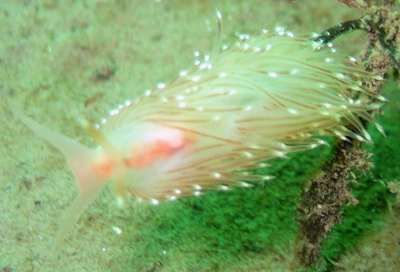
Hi there
Just wondering if anyone could identify this nudibranch? I'm no expert but it appears to resemble Flabellina browni. The photo was taken last weekend (16 November 2003) at 9m on a muddy bottom in Loch Creran, West Scotland. The sea pen, Virgularia mirabilis, is also abundant at this site, perhaps a food source for the nudibranch?
The quality of the photo isn't great but any thoughts would be much appreciated.
Many thanks,
Dan
dcbe1@hw.ac.uk
Edwards, D., 2003 (Nov 20) Flabellina browni? from Scotland. [Message in] Sea Slug Forum. Australian Museum, Sydney. Available from http://www.seaslugforum.net/find/11460Dear Dan,
Flabellina browni usually has shorter cerata and there are whitish patches on the oral tentacles. From the arrangement of the relatively long cerata I would suggest this is a species of Facelina, and although I can't see the rhinophores clearly, my first guess would be Facelina bostoniensis. However we would need to know if there are rings on the rhinophores to be sure. But I must say I am not an expert on Atlantic aeolids so let's see what the local experts have to say.
Concerning food, I don't know if any aeolids will eat sea pens such as Virgularia. As I guess you know Armina loveni supposedly eats Virgularia mirabilis but it would be great to know for certain. It's possible a species of tritoniid may also eat Virgularia so I will be intersted to hear of any observations you make. Feeding photos are always welcome.
Best wishes
Bill Rudman
Facelina bostoniensis from Scotland
November 7, 2002
From: Jim Anderson
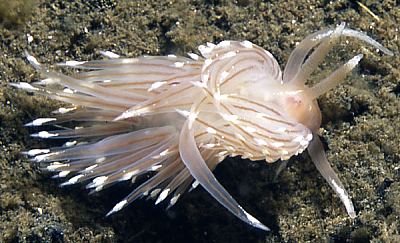
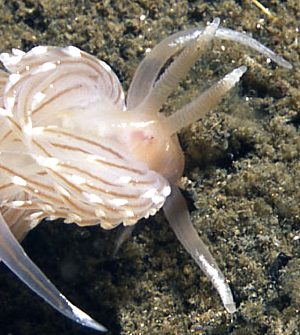
Dear Bill,
Attached is an image of Facelina bostoniensis taken recently at Jenny's Reef, Loch Long on the west coast of Scotland. On the mud at 24 metres, 13 deg C. 13 October 2002, This 20mm long individual, was one of several animals observed. This is typical of the species that I see in the sea lochs here, with long cerata and oral tentacles.
For anyone interested I have recently made some more updates to my Scottish Nudibranchs website.
Regards,
Jim Anderson
JAnder4454@aol.com
Anderson, J., 2002 (Nov 7) Facelina bostoniensis from Scotland. [Message in] Sea Slug Forum. Australian Museum, Sydney. Available from http://www.seaslugforum.net/find/8333Thanks Jim,
I have included an enlargement to show the annuli or lamellae on the rhinophores.
Best wishes,
Bill Rudman
Re: Facelina coronata or F. bostoniensis ?
July 20, 2001
From: Bernard Picton
Hi Bill,
Facelina bostoniensis can have some blue iridescence on the oral tentacles as in Miquel's photo so I have no doubt that this is what it is. Facelina dubia has smooth not lamellate rhinophores so that rules it out.
Bernard
bernard.picton.um@nics.gov.uk
Picton, B., 2001 (Jul 20) Re: Facelina coronata or F. bostoniensis ?. [Message in] Sea Slug Forum. Australian Museum, Sydney. Available from http://www.seaslugforum.net/find/4857Thanks Bernard,
Bill Rudman
Re: Facelina coronata or F. bostoniensis ?
July 20, 2001
From: Juan Lucas Cervera
Dear Bill,
Facelina dubia has smooth rhinophores. Miquel's animal has annulate ones. I think that is F. bostoniensis.
Cheers.
Lucas.
lucas.cervera@uca.es
Cervera, J.L., 2001 (Jul 20) Re: Facelina coronata or F. bostoniensis ?. [Message in] Sea Slug Forum. Australian Museum, Sydney. Available from http://www.seaslugforum.net/find/4879Thanks Lucas,
Bernard agrees that this is F. bostoniensis.
Cheers,
Bill Rudman
Re: Facelina coronata or F. bostoniensis ?
July 19, 2001
From: Juan Lucas Cervera
Dear Bill,
Even if this animal shows a mix of colour patteren between Facelina coronata and F. bostoniensis, I think that it belongs to the 2nd species. One of the main features of the 1st species is the reddish patch on the head caused by the oesopahgus. That does not appear in the 2nd one.
Cheers.
Lucas.
lucas.cervera@uca.es
Cervera, J.L., 2001 (Jul 19) Re: Facelina coronata or F. bostoniensis ?. [Message in] Sea Slug Forum. Australian Museum, Sydney. Available from http://www.seaslugforum.net/find/4850Thanks Lucas,
Any thoughts on Erwin's suggestion that it might be F. dubia?
Best wishes,
Bill Rudman
Re: Facelina coronata or F. bostoniensis ?
July 19, 2001
From: Miquel Pontes
Dear Bill,
Thanks for posting the pictures.
In a later message Erwin Köhler suggested that this nudibranch could be a Facelina dubia http://www.medslugs.de/E/Mediterranean/Facelina_dubia.htm.
I look forward to any answers.
Thank you,
Miquel.
mpontes@marenostrum.org
Pontes, M., 2001 (Jul 19) Re: Facelina coronata or F. bostoniensis ?. [Message in] Sea Slug Forum. Australian Museum, Sydney. Available from http://www.seaslugforum.net/find/4851Dear Miquel,
Yes, Facelina dubia also fits quite well, but I don't know whether the distinctive blue lines on the oral tentacles are a problem in identifying it with that species.
Best wishes,
Bill Rudman
Facelina coronata or F. bostoniensis ?
July 18, 2001
From: Miquel Pontes
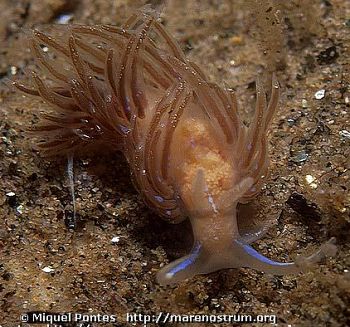
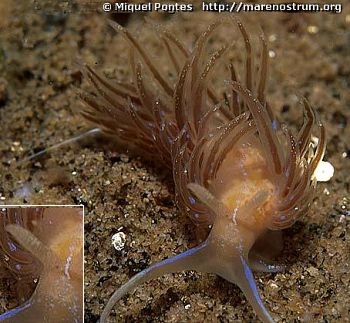
Hello Bill,
The other day [July 2001] we dived in 10 meters of water on a silt bottom in Badalona, near Barcelona (Spain), and found a lot of interesting life forms, quite different to the rocky bottom life forms we are used to. A nudibranch was hidden below a dead molusc shell and intrigued us specially...
It is clearly a Facelina but the species is not clear to us, as it seems to have characteristics of both F. coronata and F. bostoniensis.
F. coronata is more common in the Mediterranean and has blue iridiscent marks in cerata and oral tentacles, while F. bostoniensis is not as common and does not have the blue marks, showing a white line on the head instead.
The attached pictures show confuse marks for this nudibranch: the specimen has blue marks as F. coronata and a white line on the head as F. bostoniensis. Long cerata seem those of F. bostoniensis but F. coronata may have long cerata as well. Erwin Köhler's page about F. coronata [http://www.medslugs.de/E/Mediterranean/Facelina_coronata.htm] shows interesting pictures that induced us further doubts on the identification of this species. I would like to thank Luís Sánchez Tocino (Universidad de Granada) for his comments on this subject and thank you for your help.
Miquel Pontes
mpontes@marenostrum.org
Pontes, M., 2001 (Jul 18) Facelina coronata or F. bostoniensis ?. [Message in] Sea Slug Forum. Australian Museum, Sydney. Available from http://www.seaslugforum.net/find/4801Dear Miquel,
I think I will leave this to someone with local knowledge of these animals. As you say, it certainly has a mix of characters.
Best wishes,
Bill Rudman
Facelina bostoniensis from the Netherlands
September 7, 1999
From: Peter H. van Bragt
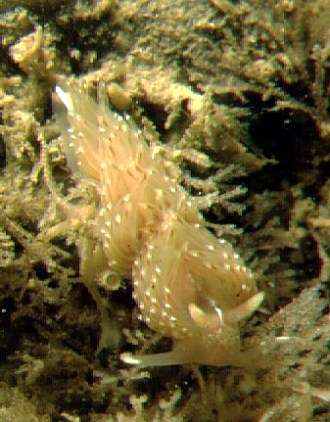
Dear Bill,
Here is a photo of Facelina bostoniensis to add to the Netherlands' List.
Location: Plompe Toren, Oosterschelde, The Netherlands, 24 September 1997
With best regards.
Peter H. van Bragt
Peter.vanBragt@ftn.hsbrabant.nl
van Bragt, P.H., 1999 (Sep 7) Facelina bostoniensis from the Netherlands. [Message in] Sea Slug Forum. Australian Museum, Sydney. Available from http://www.seaslugforum.net/find/1172Dear Peter,
It certainly good to get a range of photos of a species from different places. Yours joins Daniel Geiger's from Scotland and Betsey Hansen's from New York.
Your photo shows a distinctive median white line between the rhinophores, and on the posterior end of the foot, which is not very obvious in the other photos we have on the Forum.
Bill Rudman.
Re: Facelina bostoniensis
August 30, 1999
From: Terry Gosliner
Dear Bill,
In answer to your question, I just got a look at Daniel's photos of F. bostoniensis. They are the same. It is pretty variable depending on the hydroids they have been eating. This species is pretty cool since Couthouy named it a few years before Alder and Hancock. This is one of the few cases of an amphiatlantic species where the American name has precedence over the British one. One of the first systematic victories following the American Revolutionary War.
Terry
Thanks Terry,
Nice to see a peaceful and controlled display of revolutionary fervour. Very appropriate also, that F. bostoniensis was named after the place where the first revolutionary act, the 'Boston Tea Party', occurred. Unfortunate though that the resulting pollution from the dumped cargo of tea, probably killed the local marine life, including any Facelina bostoniensis.
Bill Rudman.
NY Flab. salmonacea is Facelina bostoniensis
August 29, 1999
From: Terry Gosliner
Dear Bill,
The species Betsey Hansen tentatively called F. salmonacea is not. It looks like Facelina bostoniensis based on the annulate rhinophores, elongate anterior foot margins and the shape of the egg mass. F. salmonacea has smooth to slightly wrinkled rhinophores, short foot corners and has a much less convoluted egg mass, with large, direct-developing eggs.
Terry.
tgosline@calacademy.org
Gosliner, T., 1999 (Aug 29) NY Flab. salmonacea is Facelina bostoniensis. [Message in] Sea Slug Forum. Australian Museum, Sydney. Available from http://www.seaslugforum.net/find/1258Thanks Terry,
I have put some photos from Scotland at the Top of the Page. They look a bit different. Is this just geographic variation or have I misidentified the Scottish animals.
Bill Rudman.
Flabellina salmonacea? from New York
August 27, 1999
From: Betsey Hansen
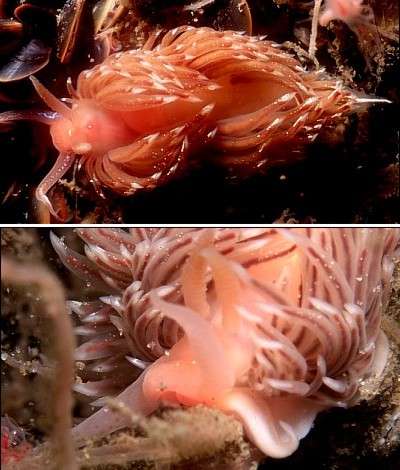
Bill,
I am sending you three slides of what I believe is Coryphella salmonacea.
One of the slides shows the eggs.
These were all taken this year on a beach dive in the Atlantic Ocean off New York at about 12 feet (4 meters). The slugs were about 1 - 1.5 inches (25 - 40mm) long.
Best wishes,
Betsey Hansen
BHScuba@aol.com
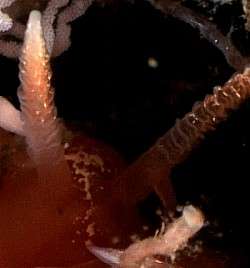
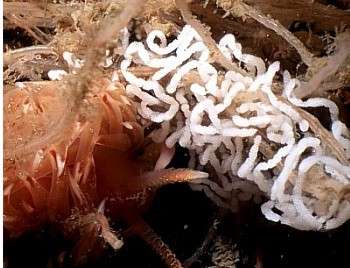
Dear Betsey,
Again, what wonderful photos. Flabellina salmonacea is described as having 'wrinkled' rhinophores. I have posted a close-up of the rhinophores to show a structure which looks a bit more complex than 'wrinkled'.
Bill Rudman.
